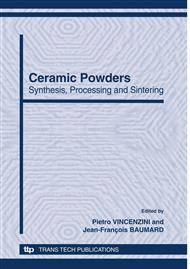p.22
p.27
p.34
p.44
p.50
p.56
p.61
p.70
p.76
Solvothermal Synthesis of ITO Nanoparticles Precisely Controlled in Size and Shape
Abstract:
Highly crystalline cubic indium tin oxide (ITO) nanoparticles with narrow size distribution were successfully prepared directly in one step from the mixed solution of indium and tin salts by the solvothermal method with lean ethylene glycol as a solvent. The addition of water must inhibit the formation of ITO crystals, but can strongly promote the formation of In(OH)3 and InOOH, including tin hydroxide. Since In(OH)3 and InOOH was not found in water-free EG system, the transformation of In(OH)3 and InOOH into In2O3 phase must be remarkably slow so that once formed indium hydroxides become final product in water-containing system. The as-prepared particles in BuOH as a solvent consist of irregular shaped nanoparticles of ITO and InOOH. In the solvothermal system with glycol as solvents, direct formation of ITO solid particles was observed starting from amorphous indium hydroxides, In(OH)3 and InOOH phases are not detected as intermediates. In addition, their size with the range from 15 to 40 nm was easily operated with changing conditions, such as aging period and sodium hydroxide concentration. X-ray diffraction measurement and high resolution transmission electron microscopic observation revealed that basically single-crystalline ITO nanoparticles were successfully obtained, and doped tin atoms were uniformly distributed in the nanoparticles.
Info:
Periodical:
Pages:
50-55
Citation:
Online since:
October 2010
Authors:
Price:
Сopyright:
© 2010 Trans Tech Publications Ltd. All Rights Reserved
Share:
Citation:


